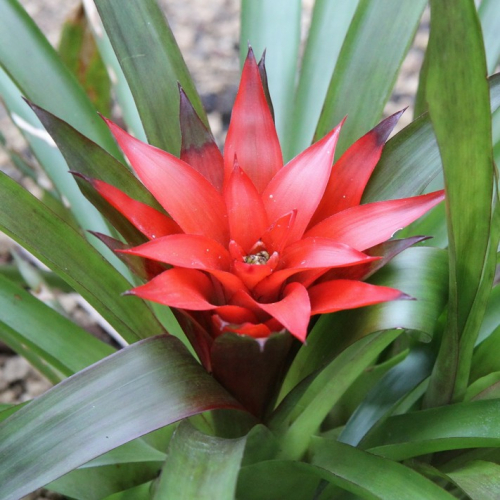Indoor plants Guzmania

Description
Special Features of Guzmania
Guzmania is a genus of evergreen herbaceous plants of the bromeliad family Bromeliaceae native to Brazil, Venezuela, Colombia, and seven countries of Central America (Panama, Costa Rica, Nicaragua, El Salvador, Honduras, Guatemala, and Belize), West Indies, as well as the southern part of Florida. The genus comprises about 130 species found in forests and on open mountain slopes, growing well at altitudes up to 2,400 metres above sea level.
The genus name is for Anastasio Guzman, an enthusiastic Spanish researcher of South American flora and fauna, which did not prevent him from searching for treasures of the Incas.
Synonymic Latin names Caraguata, Chirripoa, Massangea, Renealmia, Schlumbergera, Sodiroa, Thecophyllum, and Tillandsia are likely to be of interest only for scientists.
The three best known species are Guzmania donnell-smithii, Guzmania sanguine, and Guzmania musaica. All of these are epiphytes, i.e. they attach to other plants but do not feed on them. They take in nutrients from the soil through their roots and a host is needed as a support to help to get closer to the sunlight in a dense tropical forest and to some extent protect against herbivores. The species most commonly cultivated indoors is the Scarlet Star (Guzmania lingulata, or Tillandsia lingulata). By the way, it can also live as an epiphyte or epilite, i.e. a plant adapted to life in the stony and rocky soil. The above-ground part of this species is deceitful. The rigid basal rosette is formed of long, linear, and normally green leaves and culminates in an orange and red bracted inflorescence. Because the bract immediately attracts the eye, it is mistaken for a flower. In fact, flowers gathered in a spiked inflorescence are not so noticeable and short-lived.
The Scarlet Star has the following varieties alphabetized by their Latin names:
1) Var. cardinalis has a wide rosette formed by green leaves 3-4 centimetres wide and an equally wide purple, brilliant red, or scarlet bracts (depending on the country of origin).
2) Var. concolour has a rosette of light green leaves and dull orange bracts with deep red colouring in the upper part toward the top of the bract.
3) Var. flammea has solid green leaves 24-34 centimetres long and 1-1.7 centimetres wide that look at all points of the upper hemisphere, and flame-red bracts are directed straight upwards.
4) Var. lingulata has solid green leaves over 2.5 centimetres wide and mostly upright red or pink bracts.
5) Var. minor has leaves of no more than 2.5 centimetres wide, mostly green (or blood-green) and erect or wide, red or lemon yellow bracts.
Less common indoor varieties are Guzmania monostachia, Guzmania conifera, Guzmania wendy etc.
The Secrets to Successfully Growing Guzmania
Like some other plants of the bromeliad family (particularly Vriesea), Guzmania loves warmth and light but does not tolerate direct afternoon sunlight that can cause burns on the rosette or affect the bract colour. Place it in places out of direct sunlight (for example, in a western exposure window) or protect it from direct sunlight at certain hours. From October to February, light is low in our latitudes, so Guzmania normally goes dormant. However, there are hybrids that bloom without taking seasons into account.
In the spring and summer while Guzmania is growing, water it well but avoid waterlogging (or drying out) of soil. Put water into the central tank. In addition to watering, mist the leaves. In the winter, reduce watering. If the temperature drops below 18 ° C, stop putting water in the central tank. Always use soft water at a room temperature. The best temperatures are 20-28 ° C in the summer and 18-20 ° C in the winter (anyway, not less than 16 ° C!).
Feed the plant once a month by compound mineral fertilizer diluted at 2-3 times recommended strength.
Repot the plant once every 2 or 3 years in the spring or summer. Since Guzmania has a shallow root system, the pot or basket size can be medium (10-12 centimetres). The soil should be loose, well-aerated (do not press it, especially around the roots), and slightly acidic (pH = 5.0-6.0). Here are a few ideas for preparing the potting mix:
- Mix ground peat moss and fern roots at 1:3.
- Mix sand, peat moss, pine bark (or the bark of other conifers), and leaf mold at 1:1:2:2.
- Mix sand, clay loam, fibrous peat, and charcoal at the same ratio.
- Mix sand, loam, humus, and peat at 1:2:2:4.
- Use commercially available potting medium for orchids or ferns.
Annually top dress with fresh soil. You might want to experiment with such ingredients as sphagnum moss, peat moss, smaller or larger pieces of charcoal, crushed pine bark (or whole pieces of bark), coniferous litter, leaf mold, and sand.
Guzmania is propagated by a) layering. Root side shoots formed at the base of the mother plant; b) dividing the adult plant; c) seeds.
Guzmania does not need pruning.
Guzmania lives up to 3 years, usually blooms in the spring and summer from April to July, and dies approximately six months after the end of the bloom. This is characteristic of bromeliads. Do not discard the dying plant immediately because Guzmania develops offsets, or pups. Remove the drying leaves and wait for the pups to appear.
Potential Problems
The light brown spots on leaves indicate sunburn.
With a lack of light, Guzmania refuses to bloom.
The plant may develop root rot if overwatered. Reduce the amount of water but do not stop putting water into the central tank.
Excessive increase in humidity and ambient temperature favours the beginning and rapid development of fungal diseases.
Guzmania is a dainty dish for mealybugs, spider mites, scale insects, and coccidia and frequently gets affected by them. Spray the plant with a solution of Malathion or Actellic.







 5 351
5 351








